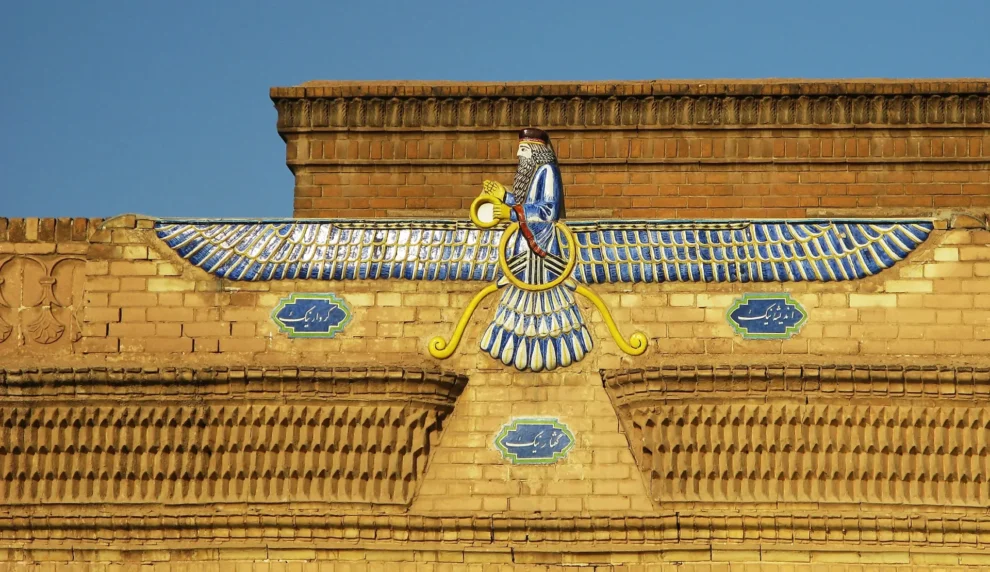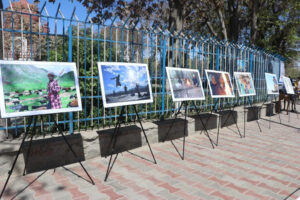Two friends who were in Afghanistan in November or December 2011, are the authors of this interesting compilation.
Being young ladies many of the sites and places were inaccessible or off limits to them, hence as stated by her below, most information is taken off the net
Zoroastrian Afghanistan
Navroze is indeed celebrated in Afghanistan today, the amazing thing is that they don’t quite know why or what the origin of these celebrations are! Other than in Kabul, there are still around 9 Zoroastrians families living in Afghanistan in the province of Balkh. Their physical and facial features are of the region. They hide their identity by having two names – one local and one Zoroastrian, they wear the local garb, speak the local language, yet retain their Zoroastrian identity. A fire in the hearth is also the holy flame! The celebration of Navroze is an affirmation that the Zoroastrian presence was so strong in the past that a major festival is still celebrated as a national one. Not only was the presence strong, as you will see below, most historians believe that Zarathustra died there; some also believe that he was born there. The following (most parts taken of the net) is a brief history of the Zoroastrian presence in Afghanistan:
A major part of Northern Afghanistan was under the Zoroastrian influence during the middle period of Aryan history – as the Aryans moved west from Airyana Vaeja towards present day Iran – Bakhdhi (Balkh as its is known today) became the principle kingdom of the Aryan confederation of kingdoms called Airan, and the city of Balkh was its capital. As the seat of Aryan rule moved westward to what is the Iranian province of Khorasan today, Balkh became part of greater Khorasan and remained an important regional capital as well as a cultural and trading center
According to Firdausi’s Shahnameh, it was during this middle period of Aryan history that Zarathustra came to the kingdom of Bakhdhi. According to some accounts, Zarathustra made Balkh his home after King Vishtasp of Bakhdhi became a patron king of Zoroastrianism. By these accounts Zarathustra also died in Balkh at the hands of a Turanian invader. Some authors conclude that in addition to Bakhdhi / Balkh being one of the areas of Zarathustra’s ministry, that he was also born in Bakhdhi / Balkh. Today, the site of the kingdom and its ancient city is called Balkh, and the once mighty kingdom has been reduced to the fairly small province in Afghanistan. Balkh’s provincial capital is now Mazar-e Sharif, a city some twenty kilometers east of Balkh city.
The Naubahar / No Gombad ruins located just south of the city of Balkh are variously described as being those of a mosque, a Zoroastrian fire temple, and a fire temple that was converted into a Buddhist temple and then into a mosque. ? Various Islamic authors such as twelfth and thirteenth century CE Islamic authors, Yaqut Ibn-Abdullah (al-Rumi) and Shams Ibn-Khallikan, note that the Naubahar structure was a Zoroastrian temple. An earlier tenth century CE author, al-Masoudi, adds in Muruuju dh Dhabab that Barmak, the ancestor of the renowned Barmaki (also Barmakiyan) family was a Magian (magi, Zoroastrian priests – a name that Islamic authors gave Zoroastrians) and high priest of great fire-temple at Naubahar.
Cheshm-e-Shafa. The City of Infidels
In the spring of 2008 French and Afghan archaeologists announced that they had uncovered the ruins of a vast, hither-to unknown, ancient city at Cheshm-e-Shafa, the City of Infidels, some 20 miles (30 kilometers) from the ruins of Balkh fortress. They found centuries-old shards of pottery mingle with spent ammunition rounds from the recent civil war on Cheshm-e-Shafa’s wind-swept mountainside.
The name, City of Infidels, suggests the locals knew that this was once an important Zoroastrian city. The team uncovered a 6-foot-tall (2-meter-tall) anvil-like stone believed to have been an altar at a fire temple dating back to around the 6th century BCE. An Afghan working at the excavation was anxious that media coverage could bring the unwanted attention of extremists to the site.
In the predominantly Tajik northern Afghan province of Baghlan, about 32 km (20 miles) on the road to Mazar-e-Sharif, are the ruins of the Atashkadeh-ye Sorkh Kowtal a 1st century Zoroastrian fire temple believed to have been built by the Kushan emperor Kaniska whose statue was found within the temple. ?The ruins have since been plundered, statues stored in a museum smashed by the Taliban, and artifacts looted. French conservationists have pieced a statue of the king together.
Built on the top and side of a hill, the temple complex would have been an imposing site, before its destruction, towering over the vast valley plains below. It was accessed by a long flight of steps leading to a stairwell, above which was a monumental stairway some fifty five meters high, rising in four flights, flanked by four terraces, to the temple on top of the hill. ??The stairs led to a temple containing an 11m. X 11m sanctuary – a cellar – in which there was a platform flanked by four columns, and on which rested a fire altar.
______________________________________________________________________________
Rusi Sorabji notes:-
It is like an odyssey through two millennia and more, discovering the discoveries made by others, of once what was ours.. ..Zoroastrians……but sad to learn that in 2009 “French archaeologists said they had been forced to stand in front of earthmovers to prevent Korean contractors building a road through a historic gorge.”
Read about the Ancient Fire Temple of Naubahar / No Gombad, also watch a video and see pictures
Are the ruins of the Atashkadeh-ye Sorkh Kowtal (also spelt Surkh Kotal), a 1st century CE Zoroastrian fire temple?
http://www.heritageinstitute.com/zoroastrianism/balkh/balkh2.htm
The Zoroastrian princess Roxanne that Alexander the Greek married in in 327 B.C., there is strong indication lived in Bactria / Cheshm-e-Shafa
http://www.cleveland.com/world/index.ssf/2008/08/archaelogists_uncover_ancient.html
Enjoy
Rusi Sorabji
Source: Zoroastrians









